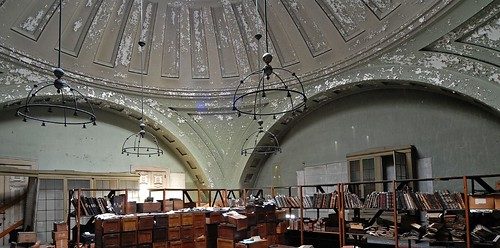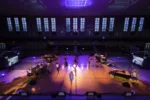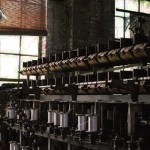Post by Jacob Hellman

Last night, a year in advanced of the much-anticipated May 2009 festival to be known as “Hidden City,” Peregrine Arts produced a trial run — an “essay” — a site-specific sound piece in Girard College‘s Founder’s Hall. LA-based artist Steve Roden gently flooded the third-floor domed chamber with “field” recordings, all made in the derelict rooms of the historic building – or, as his title puts it, “nothing but what is therein contained.”
Founders Hall is a building austere in style and imposing in scale. Through giant carved-wood doors, we ascended two flights of stairs, lit by (electric) lanterns set along the foot path. I was told there was an installation at the top, but this was not exactly correct: before taking our seats, were invited to pass a few minutes in the school’s archive room, opened specially for the occasion. They wanted us to take in the space, the strewn books, musky smell and peeling paint that no longer accompanies archiving in the digital era.
Sound samples and video
Though billed “multimedia,” Mr. Roden’s piece was in essence a work of sound, six or eight brief compositions which sampled and layered what might be called the native sounds of the building. He sat in front of us, leaning over his mixer, performing the piece in real time, and occasionally jockeying the video projected on the wall behind him. He began with a shot of foot-steps, camera on the ground, and expertly mic’d: the precise crackling the feet stepping, slow and tentative, upon paint chips, which have fallen and littered a hallway floor. This was the perfect aural texture to accompany the peeling beige paint on the rounded walls around us.
The crackling shifted into waves, the waves into drones and tones, each with an accompanying projection to contextualize it. A soft, rapid tapping, for example – the sound that is made when Mr. Roden rubs the back of his fingernails across a piece of carved wooden molding in the derelict archives room we just explored.
The videos left something to be desired, though Mr. Roden insists they are not the focus of the work. (“I want people to close their eyes,” he said, when I complained that it was projected too small for the giant room.) The sound, however, is tremendously successful, apparently chosen and mixed to reverberate and fill the room while remaining clear and rich. They are the appropriate sounds for the space, giant arches softly lit through the oculus above.
Mr. Roden, who doesn’t like his pieces loud, ended with a simple “thanks,” but the applause that followed thundered in that stone room – if you had your eyes closed, you’d think you were at the opera house. The space is monumental, but primitive. There were no lights to come on afterwards. As we rose, I overheard two cultural heavyweights seated behind me also unsatisfied with the video projection – it should either be much larger, they said, or not at all. They should enjoy the final version: instead of performing to a captive audience, Mr. Roden’s piece will play through speakers as we wander freely through the vaulted spaces. Ultimately, this fits a site-specific sound piece better: “It’s not about coming up with a piece and performing it in a space,” Roden said about the commission –”it’s having a dialogue with the space.” All eyes on Peregrine Arts next May! (In the meantime, check out A Man in A Room, Gambling, next week. )
–Jacob Hellman is a Philadelphia artist and political activist. He last wrote for Artblog about Puppet Uprising.









